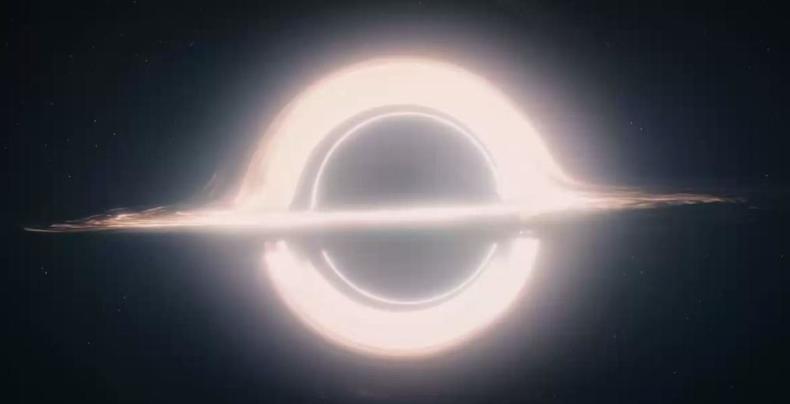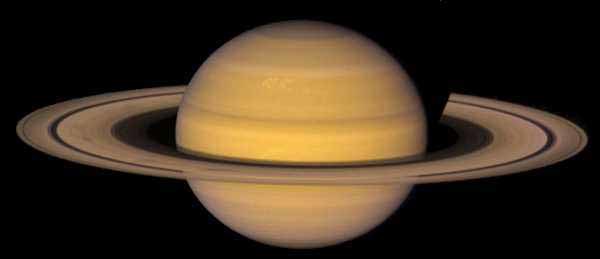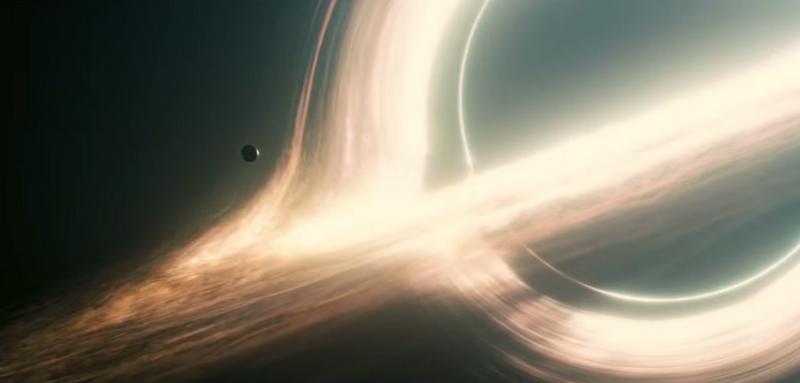If you haven’t seen the movie Interstellar, you might not recognize the image above. It’s the black hole that figures prominently in the climax. But even if you have seen the movie, chances are excellent you still don’t know what you’re looking at. I didn’t, anyway, at least the first few days I spent staring at it.
This past summer I worked on a media project involving this fictional black hole. The project didn’t come to fruition, but I did sign a confidentiality agreement, so I don’t know how much I can reveal about it. What I can discuss, however, is the science behind the movie’s black hole, if only because part of my job was to understand it.
The movie’s director and co-screenwriter Christopher Nolan has said he wanted Interstellar to show the first true image of a black hole—what it would actually look like if you were near one. And in order to achieve that goal, he said, he would try to combine science and art.
First, the science. The physicist Kip Thorne, a longtime leading theorist on black holes as well as the author of the 1994 classic Black Holes and Time Warps: Einstein’s Outrageous Legacy, served as the science consultant (and as an executive producer) on the movie. Thorne fed math—most notably, Einstein’s equations for general relativity—into Hollywood-scale supercomputers. Thorne has been feeding Einstein’s equations into computers for decades in order to model the behavior of black holes. This time, though, the computing power would be far, far beyond what’s usually available to a theorist, even a prominent one at Caltech.
Then, the art. Double Negative, the British visual effects powerhouse that has worked on more than one hundred movies in the last fifteen years, and that won the Oscar for Best Achievement in Visual Effects for Nolan’s own Inception, took Thorne’s data and brought it to digital life.
That digital life—schematic models, stills from the film, test footage—was what I examined. I instantly recognized the black sphere at the center of the image: the black hole itself, where gravity is so powerful that nothing can escape, not even light. And I recognized the ring around the middle: the accretion disk that develops as a swirling black hole sweeps up the gas from its galactic neighborhood. In some images and footage, I recognized the distortions of the background stars and galaxies: the gravitational lensing that, according to Einstein’s calculations, occurs when a great gravitational mass bends the light that passes near it. (Astronomers take advantage of this phenomenon all the time, often by using a foreground cluster of galaxies as a kind of magnifying glass to see what’s beyond it.)
Not until I spoke to Thorne, though, did I realize what’s really radical about the image—what makes it different from every other cinematic representation of a black hole as well as the vast majority of previous scientific models.
Think about Saturn.
Like a black hole, Saturn has a ring around it. (Rings, actually, but let’s simplify here.) From our point of view the ring is out of sight where it circles around the other side of Saturn.
Now look at this schematic model of Interstellar’s black hole.
Notice how the ring never goes out of sight. Rather than circle around the black hole, it appears to be rising up over the “top.”
Of course it does! I thought when I finally realized what I’d been looking at for days. Even before I started the project, I knew that the distortions from a black hole’s gravitational lensing would be so great that an observer on one side would be able to see objects located diametrically opposite. The idea is so counterintuitive, though, that in my mental inventory of what would be visible even though it was on the other side of the black hole and therefore, in principle, “out of sight,” I’d neglected to include the rest of the accretion disk.
I went back to an image of Interstellar’s black hole.
That bright arc at the “top”? That’s the accretion disk. That bright arc at the bottom? Same disk. (Gravitational lensing not only bends light but multiplies images.)
Thorne (who recently published The Science of Interstellar) told me he’d experienced his own version of an Of course! moment. As a black hole expert, he knew the “out-of-sight” portion of the disk should be visible. But theoretical physicists who model black holes are studying their behavior—their spin rates, their temperatures, and so on. The far side of the accretion disk is unnecessary data, so theorists leave it out. Now, for the first time, Thorne was seeing that effect in all—literally all—its glory.
Despite having gone to such lengths to ensure scientific accuracy, Nolan chose not to include that information in the movie, presumably because it isn’t essential to the plot: The characters don’t need to know what they’re seeing. Neither do we, I suppose. But I did know, and I have to say, I wish all viewers could see what I was seeing: a thing of truth and beauty—of science and art.
* * *
Interstellar images: Paramount Pictures.




Richard, I never thought of that, but once you pointed it out – of course! Thanks!
nick